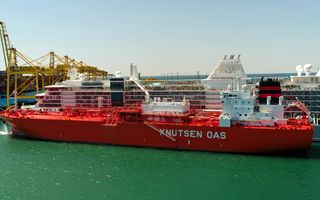(Telestock) – Edison announces that it has completed the rSupply of liquefied natural gas (LNG) in the port of Trieste. The operation of ship-to-ship bunkering It is the first one to take place in the Adriatic Sea and it is the first one carried out by Edison using the methane tanker Ravenna Knutsen, which has been supplying the Ravenna LNG coastal depot (DIG)which is part of the Group’s integrated logistics chain and contributes to the decarbonisation of road and maritime transport.
The recently concluded operation will lead to more ship-to-ship bunkering operations in the port of Trieste for the 2024 summer season.
“We are proud to support our customers in their decarbonisation journey and announce first ship-to-ship refueling of LNG in the Adriatic Sea. For this reason I would like to thank all the authorities and in particular the Port Authority of Trieste, who have made it possible to reach this important goal”, he declares Fabrizio Mattana Executive Vice President Gas Assets of Edison. “After the launch of the Ravenna coastal depot, which has become the reference in Italy for the supply of LNG in road transport, thanks to today’s operation Edison is positioned first in the LNG supply market for the maritime segment. It is a sector with a high potential for reducing its emissions and LNG is the available and competitive solution today. For consolidate our market presence we are also developing a second coastal LNG depot in Southern Italy and a second vessel ready for bunkering. Many concrete steps that confirm our commitment to sustainable mobility in Italy and the Mediterranean Sea”.
There ship Ravenna Knutsen It is a small-sized LNG carrier, unique in its kind, with extreme operational flexibility, available to Edison in under a contract with Norwegian shipowner Knutsen OAS Shipping. Built by Hyundai Heavy Industries at the Mipo shipyard in South Korea. LNG carrier can carry up to 30,000 cubic meters of LNG through 3 high nickel steel tanks and suitably insulated, to withstand cryogenic temperatures. The vessel is equipped with a double set of cargo manifolds (both low and high), which give it extreme operational versatility, making it capable of operating with depots and vessels of different sizes.
The LNG. It’s a alternative fuel in line with European and international energy transition commitments, which allows for a significant reduction in various emission factors, with the elimination of sulphur oxides and particulate matter (PM) and the reduction of nitrogen and carbon dioxide emissions. It allows compliance with the limits imposed by the International Maritime Organization for the transit of vessels in areas with sulphur emission control (SECA areas)of which the Mediterranean will become part from 1 May 2025.
